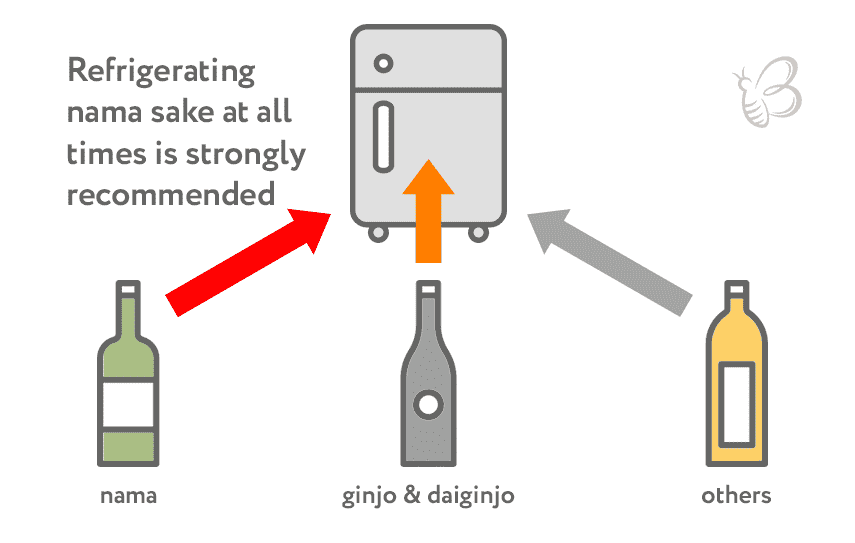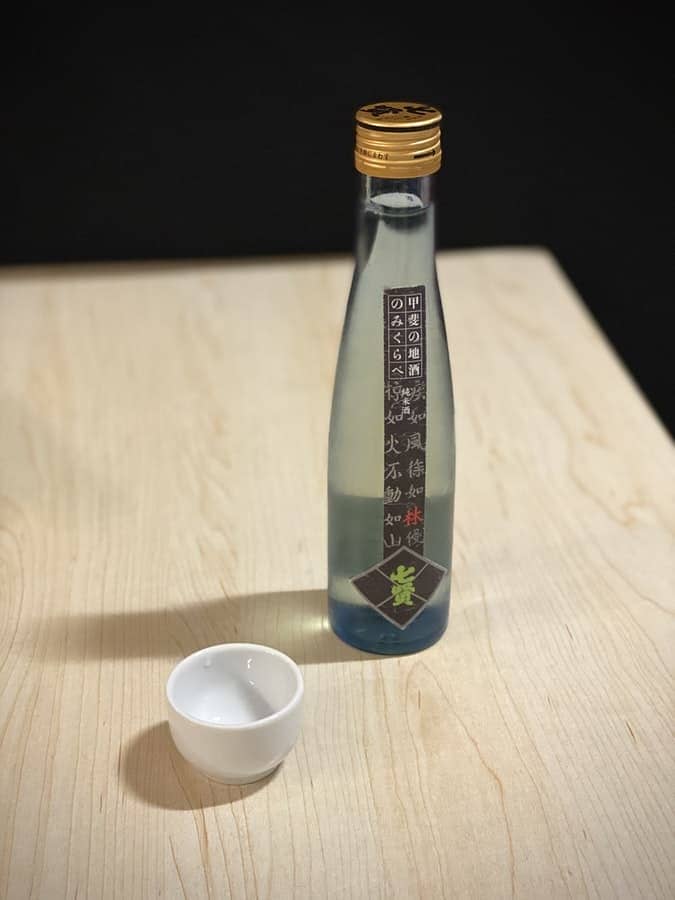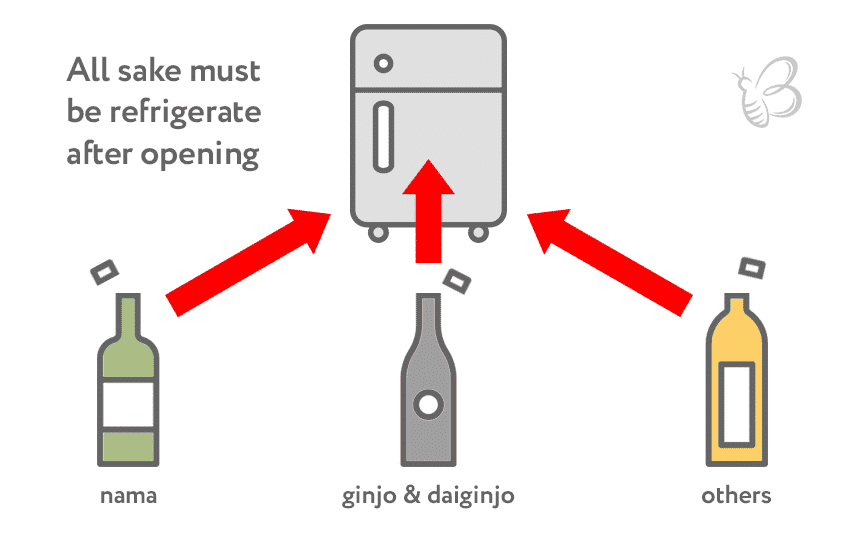Sake is not such a common drink for now compared to the more widespread beer, wine, and other alcoholic beverages. Nevertheless, the interest towards it grows rapidly, and people want to be informed about the basic rules of storing it correctly.
How to store sake so that it remains delicious and keeps its potency? This is not so complicated as it might seem!
How to Store Sake?
To be short and precise, we will tell you only one thing: keep it cool and shaded.
If you are not much familiar with this Asian rice beverage, it may seem complicated to figure out how to stock it at home. All of us heard those legends about sake being a very delicate and demanding drink in terms of storage, and that makes most consumers think twice before buying a bottle for themselves.
Does sake need to be refrigerated, consumers often ask? Where and how shall it be kept?
We can understand your worries, we really can! Especially, if it is all about a high-quality drink that costs a lot. Nobody would like wasting several hundred bucks for a drink that will be spoiled by accident just because the owner didn’t know how to deal with it properly!
Indeed, nihonshu is a very sensitive liquid, especially when it comes to exposure to light, air, and heat. This beverage is traditionally produced without the use of any preservatives or other chemicals that could save it from spoilage. Naturally, if the bottle is constantly warm, exposed to light, or oxidized, the state of its content will soon degrade.
To have this precious drink safe and sound longer, we would recommend you stick to the two simple hints:
- Do not stock the bottle in a place with the constant temperature fluctuations
When undergoing constant “swings” from cool to warm and back, sake will deteriorate quickly. Better find a cool and shaded spot of 41-58 F, and leave it there. If the heat will rise above 59 F, your beverage will be under a huge risk!
- Move it away from direct light
We don’t want any bacteria to develop in the beverage and lead to spoilage, right? So, simply ensure that the new “home” for this drink will be properly shaded.
In fact, the best way to fulfill these instructions is to refrigerate sake. Only double-check the refrigerator first since the temperature inside must be constant more or less.

Does Sake Expire?
Naturally, such a question can sooner or later occur. It is well-known that wines, for instance, can last for a pretty long period of time but they will anyway degrade one day (we assume most of you heard those stories about old wines turning into vinegar).
But what about sake? Well, this drink is rather tricky. You see, one can never find an expiry date on a bottle since it is not common for Japanese manufacturers to indicate one! They always print the production date (that basically shows when the drink was bottled, not brewed), but nobody will reveal when it is going to become off.
What shall we do then? The solution is pretty simple. Just memorize one simple consistent pattern: any sake will expire if stocked improperly.

If we leave the bottle open, stock it in a warm surrounding, or keep under the light, we shall not expect the content to last long. It will probably not even survive until the official expiry term.
To ensure that you consume a qualitative beverage, drink it within several days after opening. And remember that even an expired drink (of course, if not spoiled badly) can still be used in cooking serving as a great addition to stews and soups!
How to Store Opened Sake Bottles?
Since one of the worst sake’s enemies is air, a reasonable issue appears: what to do with the bottle once it is opened? Does sake need to be refrigerated after opening?
Let’s move step by step. This rice beverage, as we already figured out, is extremely sensitive to the external factors. Opened bottles, in particular, can be affected by air that may lead to the oxidation of the liquid inside.
To keep opened beverage correctly, follow several simple steps:
- Place the unscrewed bottle into the refrigerator. Also, should sake be refrigerated, remember to keep it tightly sealed, otherwise, the drink will lose much of its flavor and the taste will also decay.
- Consume the opened beverage within days, try not to make it last even for a week.
- Decant it into a small, tightly sealed tank to refrigerate. It is OK to leave as little space between the liquid and the cap as possible since it will reduce the risk of oxidation.
- To exclude any influence of oxygen, go for a wine preserver or that special tool that vacuum sucks the air out of the bottles.
And of course, always check the tank you are going to transfer sake into. It must be clean to prevent contamination and further spoilage.
Things to Avoid When Storing Sake

It may seem to be bothersome to memorize all those dos and don’ts when it comes to storing sake. Moreover, even though most kinds of this drink are supposed to be stocked the same way more or less, certain sorts need more attention and specific conditions.
However, the good thing is that any sake, no matter of its sort, does not go well with the following conditions that must be avoided by all means:
- Ultraviolet
Sake doesn’t like sunlight, but even the fluorescent lamps can be harmful to it! The best that can be done is to keep it either shaded or under the LED lights.
- Uneven temperature
This drink is all about stability. Even if it is kept in a generally cooled area, the presence of any heating items like the stove or even a fridge may lead to unpredictable processes in the liquid.
To avoid any unpleasant “surprises”, provide the bottle with a dark and cool surrounding that is free from any heat exposure.
- Strong smells
This is not a common threat, but certain kinds of sake are rather perceptive to strong odors. Better keep it away from the stuff like garlic, onions, or other foodstuffs that can affect the original aroma of the drink.
Any of these factors can result in sake spoilage and taste decay. Since spoiled drink tastes way too bad, it is better to follow these simple recommendations to keep it tasty and flavorful.
Does Sake Go Bad?

Can sake go bad? Shortly speaking, it can. Does sake go bad after opening? If stored correctly, both unopened and opened drinks will very unlikely to turn bad although the taste and aroma can degrade.
However, we would recommend everyone gets familiar with the signs of possible spoilage just in case:
- Yellowish tint
This beverage is initially clear. If any yellow shade appears, it shows that oxidation occurred and did some damage to the drink.
- Bad odor
Do you sense an off, pungent, or rotten smell? Well, this is bad since such a drink must only be discarded.
- Any particles in the liquid
Qualitative sake must have no sediment. If anything is floating inside of the bottle or any sediment is seen on the bottom, the nihonshu is falling apart.
- Bad taste
By tasting a bit, it is possible to figure out whether the drink is OK. Any signs of bad taste? Better discard the beverage.
Storing Temperature For Different Types Of Sake

Most of us might not be aware of that, but not all the sake can be safely stocked in a pantry. Certain kinds of this beverage will need slightly different treatment due to their production specifics.
Indeed, most of this drink can be kept in a cooled and shaded hideout safely before serving it since this rce wine is basically pasteurized to stop fermentation. However, such delicate sorts as nama, ginjo, and daiginjo will need more attention.
- Nama must be refrigerated right after we bring it home from the store. Keep the temperature colder than 40 F since this sake is unpasteurized which means that fermentation was not stopped and yeasts are still alive in it. It may lead to dramatic taste changes.
- Ginjo and daiginjo are also better to go to the fridge although these sorts are pasteurized and generally fine with the room temperature. However, some of them can be quite delicate tending to change the flavor when not being cooled enough.
One more nuance regarding temperature is that sake must be served at the temperature opposite to the one it was stocked at. It means that the beverage that was stored cooled shall be consumed warm, and vise versa.
<H2> What Is The Average Shelf Life Of Sake?
How long is the sake good for, people frequently wonder? The sake shelf life is usually one year. The drink must be consumed within this period starting from the date it was bottled. However, if the bottle was stocked correctly, we can expect the content still be of good quality even after two years or longer.
How long does open sake last? Well, it is better to finish the bottle within two weeks (of even faster) to be able to enjoy the flavor of the drink to its full.
[table id=79 /]
Why Are Sake Bottles Colored?
If you already tasted this beverage, you probably noticed that sake is sold in the dark bottles often. Usually, the color of the bottle is either black or dark-brown, however, dark-green, matt white, and dark-blue are also common.
So why so many colors? Sake is very sensitive to the UV rays as we know. When exposed to them, the beverage starts deteriorating. For preventing such dramatic effects, the manufacturers sell their beverages in darkened bottles. The darker the color of the glass, the better it protects the content from the harmful UVs.
Well, this was a brief guide about sake storage and specifics. Now you are informed about the shelf life of sake and sake expiration nuances, and we hope this information will help everyone enjoy this drink and reveal its specialty.
[wp-faq-schema title=”Frequently Asked Questions”]

Can you keep the sake in the freezer? Or maybe someone can suggest a better way of extending its lifespan?
Technically, you can freeze it, but the taste and aroma will get worse. Better refrigerate and drink asap. Anyway, it’s not supposed to be stored for ages.
I have a bottle of sake that is 2 years old by now. Can you get sick from drinking old sake? Or shall I discard it?
I’d say you should open it and check. If it smells off and/or tastes bad, discard of course. But if the drink just lost some potency but us still OK, why not use it for cooking instead?
Can sake get you drunk? I’m always wondering how Japanese can drink so much and stay sober.
Of course it can if you drink too much! I guess, Japanese don’t get drunk too fast because they warm sake up and that makes the drink weaker since alcohol evaporates.
I have ½ of sake bottle left. Can sake be kept after opening?
It can, don’t worry. Just seal it tight or remove to another, smaller bottle and seal tightly again.